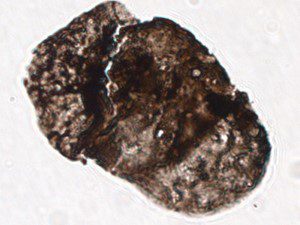250 M-Year-Old Pollen Suggests Radiation Played a Role in Mass Extinction

Alisporites tenuicorpus the pollen grain used in this work. Note a human hair is approximately 70 um so the samples analyzed are about half the width of a human hair. Credit: Liu Feng from Nanjing Institute of Geology and Paleontology
Key Points:
- New research has uncovered that pollen preserved in 250-million-year-old rocks contains to protect plants from harmful ultraviolet (UV-B) radiation.
- The findings imply plants were forced to load themselves with the sunscreen-like compounds to protect themselves from abundant UV-B radiation.
- Thus, the new study suggests UV radiation played a part in the Permian mass extinction event.
A research team examining 250-million-year-old rocks found pollen that contains compounds that function like sunscreen. The compounds are normally only produced by plants to protect themselves from harmful ultraviolet (UV-B) radiation. The authors say the findings suggest that a pulse of UV-B played an important part in the end Permian mass extinction event.
The Permian mass extinction event is the most severe of the big five mass extinction events with the loss of ~80% of marine and terrestrial species. The prevailing theory is that the event was a response to a paleoclimate emergency triggered by a volcanic eruption that covers much of modern-day Siberia. The volcanic activity drove the release of massive amounts of carbon that had been locked up in Earth’s interior into the atmosphere, generating large-scale greenhouse warming. Accompanying this global warming event was a collapse in the Earth’s ozone layer.
And now, support for this theory comes from the abundant occurrence of malformed spores and pollen grains that testify to an influx of mutagenic UV irradiation, the researchers say.
“We have developed a method to detect these phenolic compounds in fossil pollen grains recovered from Tibet, and detected much higher concentrations in those grains that were produced during the mass extinction and peak phase of volcanic activity,” explained Liu Feng, study author and professor at Nanjing Institute of Geology and Paleontology in China.
The compounds would not have been present in the plants if they were not “needed.”
“Plants require sunlight for photosynthesis but need to protect themselves and particularly their pollen against the harmful effects of UV-B radiation. To do so, plants load the outer walls of pollen grains with compounds that function like sunscreen to protect the vulnerable cells to ensure successful reproduction,” said Barry Lomax, study author and professor at the University of Nottingham.
Elevated UV-B levels can have further-reaching and longer-lasting impacts on the entire Earth system, say the authors. Recent modelling studies have demonstrated that elevated UV-B stress reduces plant biomass and terrestrial carbon storage, which would exacerbate global warming. The increased concentration of phenolic compounds also makes plant tissue less easily digestible, making a hostile environment even more challenging for herbivores.
Information provided by University of Nottingham.
We are here to share current happenings in the bee industry. Bee Culture gathers and shares articles published by outside sources. For more information about this specific article, please visit the original publish source: 250 M-Year-Old Pollen Suggests Radiation Played a Role in Mass Extinction (laboratoryequipment.com)








